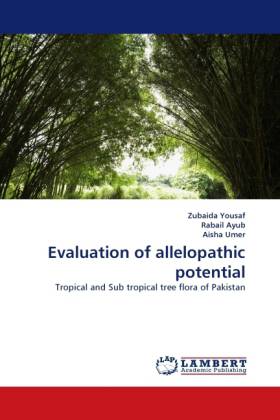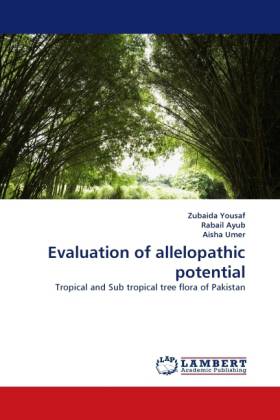
- Afhalen na 1 uur in een winkel met voorraad
- Gratis thuislevering in België vanaf € 30
- Ruim aanbod met 7 miljoen producten
- Afhalen na 1 uur in een winkel met voorraad
- Gratis thuislevering in België vanaf € 30
- Ruim aanbod met 7 miljoen producten
Zoeken
Evaluation of allelopathic potential
Tropical and Sub tropical tree flora of Pakistan
Zubaida Yousaf, Rabail Ayub, Aisha Umer
Paperback | Engels
€ 48,45
+ 96 punten
Omschrijving
Allelopathy is new emerging science, which indicates inhibitory or stimulatory biochemical interactions between the two plant species. Prof. Hans Molisch, a German Plant Physiologist coined this term in 1937. International Allelopathy Society in 1996 broadened its definition as any process involving secondary metabolites produced by plants, microorganisms, viruses and fungi.Agricultural and Biological Systems. Trees are the most dominant form of vegetation in phyto-community Allelochemicals released from trees either in atmosphere (volatilization) or in soil (root exudation and leaching). The allelopathic effects are selective, varies with different trees because these plants have different phytochemicals. Tropical and subtropical areas are rich in tree flora and play vital role in determination of community composition. Therefore it is important to evaluate the allelopathic potential of trees. The analysis should help shed some light on this new and exciting field of research, and will be very useful to plant ecologists.
Specificaties
Betrokkenen
- Auteur(s):
- Uitgeverij:
Inhoud
- Aantal bladzijden:
- 80
- Taal:
- Engels
Eigenschappen
- Productcode (EAN):
- 9783843351119
- Verschijningsdatum:
- 20/10/2010
- Uitvoering:
- Paperback
- Afmetingen:
- 152 mm x 229 mm
- Gewicht:
- 127 g

Alleen bij Standaard Boekhandel
+ 96 punten op je klantenkaart van Standaard Boekhandel
Beoordelingen
We publiceren alleen reviews die voldoen aan de voorwaarden voor reviews. Bekijk onze voorwaarden voor reviews.











